Parse mysql's self-connection and join association
This article mainly introduces you to the relevant information about mysql's self-connection and join association. The introduction in the article is very detailed. I believe it has certain reference value for everyone. Friends who need it can come below. Let’s take a look.
1. mysql self-connection
mysql sometimes needs to connect itself (self-connection) when querying information , so we need to define an alias for the table. Let's give an example. The following is a product purchase table. We need to find all the information whose purchase price is higher than Huihui.
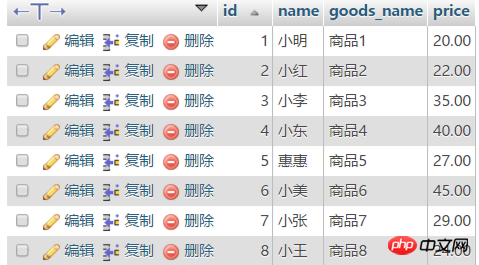
Generally speaking, when we see this table, we use the statement to operate it as soon as possible:
SELECT * FROM shoping WHERE price>27
As you can imagine, how simple this is, What if you don’t know the detailed data of the database table or the amount of data is quite large? As a database administrator, we must use other methods to quickly find the data we need.
Step-by-step query
The simplest way is also the easiest to think of the operation:
SELECT price FROM shopping WHERE name='惠惠' //得出price查询结果为27 SELECT * FROM shopping WHERE price>27
Compared with the self-connection method, This method requires manual intervention on intermediate results, which is obviously not conducive to automatic processing operations in the program.
Self-connection method:
SELECT b.* from shopping as a,shopping as b where a.name='惠惠' and a.price<b.price order by b.id
We can obtain the following table information:
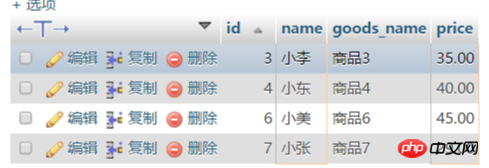
Note:
Although aliases a and b have different names, they are the same table. The purpose of defining aliases is to make it easier to delete them.
The b.* obtained by executing select through (intermediate table) is the final result.
Subquery
Subquery is also a commonly used method, which is to nest select within select.
The implementation code is as follows:
SELECT * FROM shopping WHERE price>(select price from 'shopping' where name='惠惠')
The results are as follows. It can be seen that the results obtained by the two methods are the same:
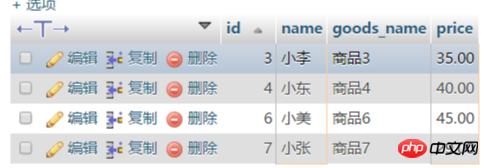
2. JOIN
##INNER JOIN
The main function of inner association is that when there is at least one match in the table, Return the result set. The inner join and join here have the same function, so they are introduced together.The following are two tables, the goods and category tables:
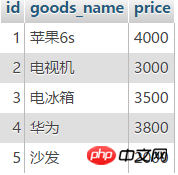

##
SELECT * FROM goods INNER JOIN category ON goods.id=category.goods_id ORDER BY gods.id
The results are as follows:
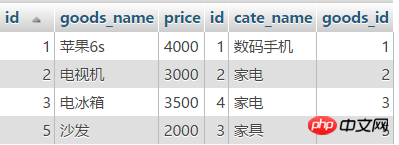
JOINLEFT JOIN keyword will be selected from the left table ( table_name1) returns all rows there, even if there are no matching rows in the right table (table_name2). It is recommended to use left association when working on projects. However, there are many table relationships. One table is a left join to a, but at the same time it is a right join to b. In this case, adding a right join may be more convenient to write.
Apply the first two tables to perform left correlation query:
SELECT goods.*,category.cate_name FROM goods LEFT JOIN category ON goods.id=category.goods_id ORDER BY goods.id
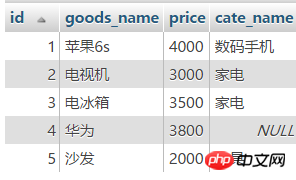
##RIGHT
The RIGHT JOIN keyword will return all rows from the right table (table_name2), even if there are no matching rows in the left table (table_name1). Apply the first two tables to perform a right correlation query: The above is the detailed content of Parse mysql's self-connection and join association. For more information, please follow other related articles on the PHP Chinese website!SELECT a.goods_name,a.price,b.*
FROM goods as a
RIGHT JOIN category as b
ON a.id=b.goods_id
ORDER BY b.id

Hot AI Tools

Undresser.AI Undress
AI-powered app for creating realistic nude photos

AI Clothes Remover
Online AI tool for removing clothes from photos.

Undress AI Tool
Undress images for free

Clothoff.io
AI clothes remover

AI Hentai Generator
Generate AI Hentai for free.

Hot Article

Hot Tools

Notepad++7.3.1
Easy-to-use and free code editor

SublimeText3 Chinese version
Chinese version, very easy to use

Zend Studio 13.0.1
Powerful PHP integrated development environment

Dreamweaver CS6
Visual web development tools

SublimeText3 Mac version
God-level code editing software (SublimeText3)

Hot Topics
 PHP's big data structure processing skills
May 08, 2024 am 10:24 AM
PHP's big data structure processing skills
May 08, 2024 am 10:24 AM
Big data structure processing skills: Chunking: Break down the data set and process it in chunks to reduce memory consumption. Generator: Generate data items one by one without loading the entire data set, suitable for unlimited data sets. Streaming: Read files or query results line by line, suitable for large files or remote data. External storage: For very large data sets, store the data in a database or NoSQL.
 How to use MySQL backup and restore in PHP?
Jun 03, 2024 pm 12:19 PM
How to use MySQL backup and restore in PHP?
Jun 03, 2024 pm 12:19 PM
Backing up and restoring a MySQL database in PHP can be achieved by following these steps: Back up the database: Use the mysqldump command to dump the database into a SQL file. Restore database: Use the mysql command to restore the database from SQL files.
 How to optimize MySQL query performance in PHP?
Jun 03, 2024 pm 08:11 PM
How to optimize MySQL query performance in PHP?
Jun 03, 2024 pm 08:11 PM
MySQL query performance can be optimized by building indexes that reduce lookup time from linear complexity to logarithmic complexity. Use PreparedStatements to prevent SQL injection and improve query performance. Limit query results and reduce the amount of data processed by the server. Optimize join queries, including using appropriate join types, creating indexes, and considering using subqueries. Analyze queries to identify bottlenecks; use caching to reduce database load; optimize PHP code to minimize overhead.
 How to insert data into a MySQL table using PHP?
Jun 02, 2024 pm 02:26 PM
How to insert data into a MySQL table using PHP?
Jun 02, 2024 pm 02:26 PM
How to insert data into MySQL table? Connect to the database: Use mysqli to establish a connection to the database. Prepare the SQL query: Write an INSERT statement to specify the columns and values to be inserted. Execute query: Use the query() method to execute the insertion query. If successful, a confirmation message will be output.
 How to create a MySQL table using PHP?
Jun 04, 2024 pm 01:57 PM
How to create a MySQL table using PHP?
Jun 04, 2024 pm 01:57 PM
Creating a MySQL table using PHP requires the following steps: Connect to the database. Create the database if it does not exist. Select a database. Create table. Execute the query. Close the connection.
 How to use MySQL stored procedures in PHP?
Jun 02, 2024 pm 02:13 PM
How to use MySQL stored procedures in PHP?
Jun 02, 2024 pm 02:13 PM
To use MySQL stored procedures in PHP: Use PDO or the MySQLi extension to connect to a MySQL database. Prepare the statement to call the stored procedure. Execute the stored procedure. Process the result set (if the stored procedure returns results). Close the database connection.
 How to fix mysql_native_password not loaded errors on MySQL 8.4
Dec 09, 2024 am 11:42 AM
How to fix mysql_native_password not loaded errors on MySQL 8.4
Dec 09, 2024 am 11:42 AM
One of the major changes introduced in MySQL 8.4 (the latest LTS release as of 2024) is that the "MySQL Native Password" plugin is no longer enabled by default. Further, MySQL 9.0 removes this plugin completely. This change affects PHP and other app
 The difference between oracle database and mysql
May 10, 2024 am 01:54 AM
The difference between oracle database and mysql
May 10, 2024 am 01:54 AM
Oracle database and MySQL are both databases based on the relational model, but Oracle is superior in terms of compatibility, scalability, data types and security; while MySQL focuses on speed and flexibility and is more suitable for small to medium-sized data sets. . ① Oracle provides a wide range of data types, ② provides advanced security features, ③ is suitable for enterprise-level applications; ① MySQL supports NoSQL data types, ② has fewer security measures, and ③ is suitable for small to medium-sized applications.






